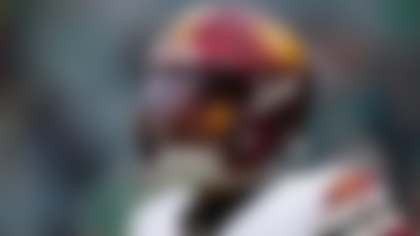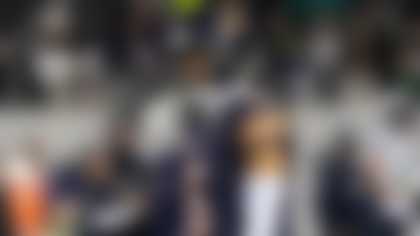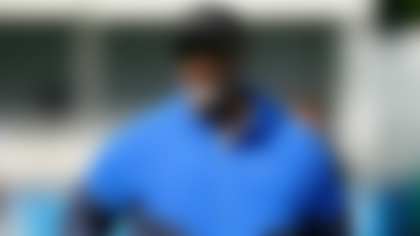INDIANAPOLIS -- Alabama defensive tackle Terrence "Mount" Cody must have seen what's going on with the NFL lately.
Steelers' nose tackle Casey Hampton just received a three-year, $21 million extension. Green Bay nose tackle Ryan Pickett, New England nose tackle Vince Wilfork and San Francisco defensive tackle Aubrayo Franklin had franchise tags placed on them by their teams, guaranteeing them just more than $7 million next season if long-term deals can't be worked out. Two of the projected top three draft picks, Nebraska's Ndamukong Suh and Oklahoma's Gerald McCoy, are defensive tackles.
When you're hot, you're hot. Right now, defensive tackles are hot.
Wanting to immerse himself in this rare flame of attention being cast on players at his position, Cody has lost 16 pounds in the past month to get to 354 pounds in hopes to increase his draft stock. A strong showing at the NFL Scouting Combine on Monday and continued attention to his fitness before the April 22-24 draft and he could find himself ascending.
"When you feel you can get a good one, you get him," Jets general manager Mike Tannenbaum said as to why defensive tackles have become in vogue. "That's why we've seen a couple extensions, a couple guys get tagged. That trend doesn't surprise me and it will continue. In working with (coach) Rex [Ryan], as much as he likes the little guys and small ball, if you can't hold up, up front, nothing else really matters."
The majority of current NFL defensive tackles that have been locked up by their teams with millions are nose tackles in 3-4 fronts. They're the massive space eaters like Pickett and Wilfork, who line up over the center and don't rack up a lot of stats because they occupy offensive linemen so linebackers and safeties can make plays.
Cody is the prototype 3-4 nose tackle, being massive and all like Franklin, Hampton, Pickett, Wilfork, New York's Kris Jenkins, Cleveland's Shaun Rogers and Baltimore's Pro Bowler Haloti Ngata. Though Cody is not viewed among the top 5 defensive tackles in the draft, he could fill a serious need for a team that plays a 3-4 front and could be selected earlier than projected.
"They're just so hard to find," Falcons coach Mike Smith said of good defensive tackles, especially 3-4 nose tackles. "That's also a tough position physically and mentally."
Suh and McCoy are viewed not only as the two best defensive tackles, but two of the best players in the draft because they were frighteningly and consistently dominant. With their size and versatility, each can play in a 3-4 or a 4-3 scheme, some coaches said. They could play either of the two tackle spots in a four-man front or move from nose tackle to end in a three-man front.
"Those guys' skill set allows them to play in any scheme," Smith said of Suh and McCoy. "They can be a true nose tackle in a 3-4, where you want to stack double teams. When you're a 4-3 guy (you) want to penetrate gaps and make plays. From my evaluation, those guys can do both."
Smith and the Falcons were one of three teams who drafted defensive tackles in the first round last season, choosing Mississippi's Peria Jerry with the 24th overall selection. Green Bay, which converted to a 3-4 scheme before the 2009 season, selected B.J. Raji out of Boston College with the ninth overall pick. Pittsburgh closed the first round by taking Missouri's Ziggy Hood. Both Jerry and Raji were set back by injuries, while Hood had a minimal impact.
Though injuries are what they are, the lack of immediate success of defensive tackles that have been drafted in the first round recently prompt reluctance among some teams to use a high pick at that position, regardless of the player. A quick glance over the past few drafts highlights why some teams could be skittish:
In 2007, Houston selected Amobi Okoye 10th overall, St. Louis chose Adam Carriker 13th and Green Bay drafted Justin Harrell 16th. In 2008, Kansas City drafted Glenn Dorsey fifth and the Saints took Sedrick Ellis at No. 7. The Falcons thought seriously about selecting Dorsey with the No. 3 pick but they opted for quarterback Matt Ryan. Imagine if things were flipped.
Though it's too early to label those defensive tackles as being overdrafted, Okoye, Ellis, Carriker, Harrell and Dorsey were pegged as can't-miss types, not projects. The returns have yet to materialize -- mainly because of injuries -- but they haven't materialized nonetheless.
Not all has gone bad for recent first-round defensive tackles. Ngata was selected 12th in 2006 by Baltimore before Philadelphia took Brodrick Bunkley 14th. Ngata is one of the most dominant defensive players in the NFL and Bunkley is solid. Tempering things, John McCargo, drafted 26th by Buffalo that same year, hasn't done much.
Defensive tackles steal spotlight
The presence of Nebraska's Ndamukong Suh and Oklahoma's Gerald McCoy makes defensive tackle the strongest position in the draft, writes Vic Carucci. **More ...**
"One thing about the defensive tackle position, in general, you talk about a high pick like that, what you're looking for, you want an impact player," Texans general manager Rick Smith said. "It takes special qualities for a player to come in this league and impact the game at that position. He's got to be very gifted athletically and he's got to be able to acclimate to the game and schemes. It's a tough position to come in and impact the game right away."
Past shortcomings by other players don't seem to be impacting the evaluations of Suh and McCoy. Just about any team would take either of them, including those with the top three picks: St. Louis, Detroit and Tampa Bay -- all of which need defensive tackles. There is widespread chatter at the combine that the Rams will use the No. 1 selection on quarterback Sam Bradford if his injured shoulder is healthy. More than the exact science of things, some of the rationale -- and it's solid thinking -- is they have to go quarterback because they need one and their past three first-round picks, one being Carriker, have fallen on the offensive and defensive lines.
It is still too soon for even the Rams to know what they'll do with the top selection but whatever happens, one of the top defensive tackles will remain -- but not for long. Once Suh and McCoy are gone, Dan Williams, Brian Price, Jared Odrick and Cody are considered the best of the remaining defensive tackles. They might not be taken in the first round, but that might not matter. As we've seen with Hampton, Wilfork and Franklin, they are valued if they show they can play in the NFL.



